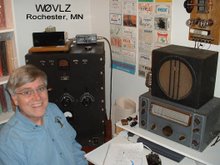The 1986 Callbook lists W2SN as Vernon Clifford, Amityville, NY. He got into ham radio in the early 30s using a TNT transmitter. Almost 50 years later he decided to build an exact replica of his first rig. Finished, it looked good but when he put it on the air he got a T7 report with a bad chirp. In these two papers he details what he tried (and learned) as he attempted to clean up his signal.
Most of us have had a much better experience with the TNT transmitter than W2SN but I've heard some pretty crummy signals also. There is no doubt that the TNT circuit can misbehave with no one "silver bullet" fix but W2SN tried a lot of fixes and nothing seemed to work. My TNT transmitter certainly sounds better on 80 than on 40. Perhaps most of W2SN's testing was on 40 or, heaven forbid, 20. He also never showed the layout of his transmitter. Perhaps there was a basic problem there.
W2SN does make several points beyond the typical TNT transmitter construction/setup instructions to look at including:
- Try DC versus AC on the filaments
- If AC filaments, check that the center tap resistor is centered
- Bypass and/or choke the power and keying leads to minimize stray pickup
- Don't use a wood (or wood filler) grid coil form
- Insure a well filtered and stiff B+ supply
- Tune the antenna network to minimize RF in the shack
- Insure a good station ground to minimize RF in the shack
- The value of the grid leak
- The value of the filament bypass capacitors
- Bad feedback stability due to changing tube grid-plate capacitance
My TNT transmitter shows some (if not all) of the same problems that W2SN saw on 40 mtrs but sounds fine on 80. Next fall I'll look at some of the areas that W2SN mentioned to see if I can get a better signal on 40.
( Have you seen a polished version of these articles? If so, please let me know.)

No comments:
Post a Comment